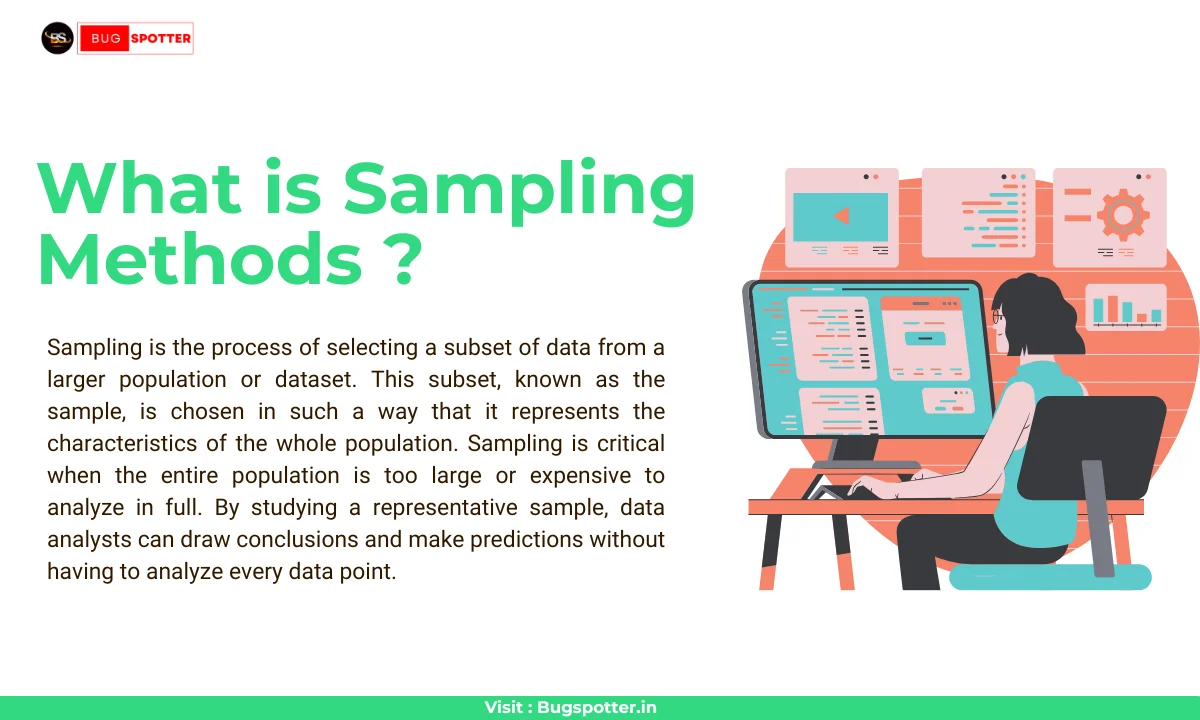Introduction to Sampling Methods

Introduction
In the world of data analysis, working with large datasets can often be time-consuming, resource-intensive, and impractical. Fortunately, sampling methods allow data analysts to work with a smaller subset of data that accurately represents the entire population. Whether you’re conducting surveys, analyzing trends, or building predictive models, understanding sampling techniques is essential. In this blog post, we will explore the different sampling methods, why they are important, and how they help data analysts derive meaningful insights from limited data.
What is Sampling Methods
Sampling is the process of selecting a subset of data from a larger population or dataset. This subset, known as the sample, is chosen in such a way that it represents the characteristics of the whole population. Sampling is critical when the entire population is too large or expensive to analyze in full. By studying a representative sample, data analysts can draw conclusions and make predictions without having to analyze every data point.
Why Sampling Methods are Important?
Sampling methods are essential for several reasons:
- Efficiency: Analyzing large datasets can be computationally expensive and time-consuming. Sampling allows analysts to make quicker decisions using smaller datasets.
- Cost-Effective: In fields like market research or medical studies, collecting data from every individual in the population can be costly. Sampling reduces costs while maintaining the reliability of the results.
- Practicality: Sometimes it’s physically impossible or unethical to collect data from everyone in the population. Sampling provides a feasible way to make generalizations about larger groups based on limited data.
The key to successful sampling is ensuring that the sample accurately represents the population, which is why choosing the right sampling method is crucial.
Types of Sampling Methods
There are two main categories of sampling methods: Probability Sampling and Non-Probability Sampling. Let’s explore these in detail.
1. Probability Sampling
In probability sampling, every individual in the population has a known, non-zero chance of being selected. This method ensures that the sample is representative and allows for statistical analysis, such as estimating population parameters and testing hypotheses. There are several types of probability sampling:
1.1 Simple Random Sampling
- Definition: Simple random sampling is the most basic form of probability sampling, where every individual in the population has an equal chance of being selected.
- How it works: Randomly select participants, typically using a random number generator or drawing lots.
- When to use it: This method is effective when the population is homogeneous, and there is no inherent order or grouping.
- Advantages: It’s straightforward, unbiased, and easy to implement.
- Disadvantages: It can be impractical for large populations, as it may require a full list of the population.
1.2 Stratified Sampling
- Definition: Stratified sampling involves dividing the population into distinct subgroups, or strata, based on a shared characteristic (e.g., age, income, gender) and then randomly sampling from each stratum.
- How it works: First, the population is divided into strata, then a random sample is taken from each group. The proportion of the sample from each stratum should reflect the proportion of that stratum in the population.
- When to use it: This method is useful when the population consists of different subgroups that may exhibit different behaviors or characteristics.
- Advantages: Stratified sampling improves the precision of estimates by ensuring that all relevant subgroups are represented.
- Disadvantages: It requires detailed information about the population to create strata, which may not always be available.
1.3 Systematic Sampling
- Definition: Systematic sampling involves selecting every k-th individual from a list after randomly selecting a starting point.
- How it works: If the population size is N and you want to sample n individuals, you select every k-th individual where k = N/n. You start at a random point and then select individuals at regular intervals.
- When to use it: Systematic sampling is ideal when the population is ordered, and a random starting point is feasible.
- Advantages: It’s easier to implement than simple random sampling and often more practical.
- Disadvantages: If there’s a hidden periodicity in the population data, it could introduce bias.
1.4 Cluster Sampling
- Definition: Cluster sampling divides the population into clusters (usually based on geographic location or another natural grouping), and then a random sample of clusters is selected. All individuals within the selected clusters are included in the sample.
- How it works: The population is divided into clusters, and then entire clusters are randomly selected for sampling.
- When to use it: Cluster sampling is useful when the population is geographically spread out or when data collection across the entire population would be too expensive or impractical.
- Advantages: It is cost-effective and practical for large or geographically dispersed populations.
- Disadvantages: It may lead to less precise estimates if the clusters are not homogeneous.
2. Non-Probability Sampling
In non-probability sampling, not every individual has a known or equal chance of being selected. These methods are generally less accurate and are used when random sampling is not feasible or when the goal is to explore trends rather than make generalizations about the population.
2.1 Convenience Sampling
- Definition: Convenience sampling involves selecting individuals who are easiest to access or contact.
- How it works: Data is collected from individuals who are readily available, such as volunteers, customers in a store, or people within close proximity.
- When to use it: It’s useful when the goal is to conduct quick, preliminary research.
- Advantages: It’s fast, inexpensive, and easy to implement.
- Disadvantages: It often leads to biased samples and cannot be generalized to the broader population.
2.2 Judgmental (Purposive) Sampling
- Definition: Judgmental sampling relies on the researcher’s knowledge and judgment to select specific individuals who are thought to be representative of the population.
- How it works: The researcher selects participants based on their expertise or judgment, often focusing on individuals with specific characteristics.
- When to use it: This method is used when a targeted approach is necessary, such as selecting experts in a particular field.
- Advantages: It can provide useful insights in niche areas or for in-depth study.
- Disadvantages: It can introduce bias due to the subjective selection of participants.
2.3 Snowball Sampling
- Definition: Snowball sampling is a method where initial participants are asked to refer other participants, creating a chain of referrals.
- How it works: This method is commonly used in hard-to-reach populations or for research on sensitive topics, where participants are difficult to identify.
- When to use it: It’s useful for studying populations that are small or hidden, such as drug users, the homeless, or specific subcultures.
- Advantages: It’s effective for reaching individuals who are hard to locate or who belong to specialized groups.
- Disadvantages: It can lead to biased samples as it relies on the recommendations of a few individuals.
Probability Sampling Methods
In probability sampling, every member of the population has a known, non-zero chance of being selected. This ensures that the sample is representative and minimizes bias. Common probability sampling methods include:
- Simple Random Sampling: Each individual has an equal chance of being selected, typically using random number generators or a lottery system.
- Systematic Sampling: Every nth element is selected from a list, starting from a random point.
- Stratified Sampling: The population is divided into subgroups (strata) based on certain characteristics (e.g., age, gender), and samples are drawn from each stratum.
- Cluster Sampling: The population is divided into clusters, and entire clusters are randomly selected for the sample.
Non-Probability Sampling Methods
In non-probability sampling, not every member of the population has a known or equal chance of being included in the sample, which may lead to bias. These methods are often used in exploratory research or when probability sampling is not feasible. Common non-probability methods include:
- Convenience Sampling: Sampling is done from the easiest or most convenient members of the population.
- Judgmental (Purposive) Sampling: The researcher selects individuals who are considered to be the most knowledgeable or relevant to the study.
- Snowball Sampling: Participants refer other participants, often used in studies involving hard-to-reach or hidden populations.
- Quota Sampling: The researcher ensures specific subgroups of the population are represented, but the sample is not chosen randomly.
Latest Posts
- All Posts
- Software Testing
- Uncategorized





Categories
- Artificial Intelligence (5)
- Best IT Training Institute Pune (9)
- Cloud (2)
- Data Analyst (55)
- Data Analyst Pro (15)
- data engineer (18)
- Data Science (104)
- Data Science Pro (20)
- Data Science Questions (6)
- Digital Marketing (4)
- Full Stack Development (7)
- Hiring News (41)
- HR (3)
- Jobs (3)
- News (1)
- Placements (2)
- SAM (4)
- Software Testing (70)
- Software Testing Pro (8)
- Uncategorized (33)
- Update (33)
Tags
- Artificial Intelligence (5)
- Best IT Training Institute Pune (9)
- Cloud (2)
- Data Analyst (55)
- Data Analyst Pro (15)
- data engineer (18)
- Data Science (104)
- Data Science Pro (20)
- Data Science Questions (6)
- Digital Marketing (4)
- Full Stack Development (7)
- Hiring News (41)
- HR (3)
- Jobs (3)
- News (1)
- Placements (2)
- SAM (4)
- Software Testing (70)
- Software Testing Pro (8)
- Uncategorized (33)
- Update (33)





